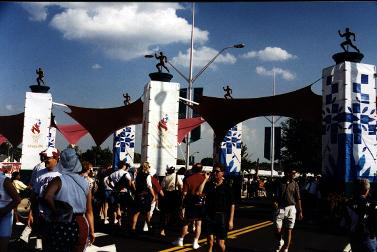|
The Olympic Venue Experience
The collection or dispersion of the Olympic venues is critical in shaping the overall Olympic experience for athletes, spectators, television audience, and host city residents. Are the major venues clustered in a grouping as we saw in Barcelona, Spain, and will soon see in Sydney, or are that dispersed about the host city, as was the case in Los Angeles and Atlanta? This is a significant decision and is driven by many issues including; the available inventory of sports venues, the overall development budget and the strategy intended for venue reuse. After this decision is made, there are several factors that guide the development of venues: the legacy left to the city, the context of the city itself and the character of the facilities that will house the events.
Legacy Legacies are both physical and non-physical reminders of the Olympic experience. The physical legacy includes the built facilities remaining in the community after the event; stadiums, housing, infrastructure, public transportation or parks - to name a few. Another type of legacy deals with community development, which may support expansion of “grass roots” sports programs to increase interest and participation in athletics. The memories and personal experiences of those who witnessed or participated in the event make up the non-physical legacy, which are as important as the physical legacies.
Context Context can be defined as the interrelationship between the Olympic Games and their surrounding environment in the host city. This local context shapes the Olympic experience and vice versa the Olympic event leaves a strong influence on the context. This symbiotic relationship must be evaluated in the planning and development of the event to help create the intended legacy. A good example of utilizing and impacting context is La Rambla Street in Barcelona, Spain. This romantic, local streetscape became the “heart” of the Barcelona Olympics. Its restaurants and entertainment exposed the world to Spanish culture and positively influenced the event.
Character Character describes the physical attributes that serve an Olympics. Each venue will be unique in its requirements and identity. However, to establish cohesion and an overall image, there must be a unifying element that links the various components. In many countries and climates, trees and flowers may be used as a common element. Architectural elements, such as unifying shapes, colors or materials, also may tie the venues together. |

|
Temporary Entry Portal to the Olympic Stadium. |